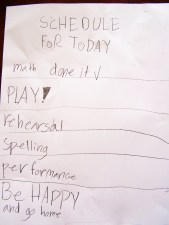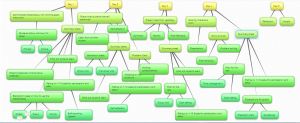This week I learned a lot more about the principals of UDL (Universal Design for Learning). UDL is all about adapting your classroom for all learners to ensure every student gets a fair opportunity to learn. Fortunately, all the changes that you make to your classroom to help some students ends up helping all students. Schools that have easy access to text-to-speech applications helps dyslexic students, ADD students, auditory student, hard-of-hearing students, and more!
To really immerse myself in these ideas I was asked by my CEP 811 course to look back over a lesson plan I created a few weeks ago and make changes that help all students. If you’ve been following my blog you may remember the lesson that I created where students worked together using a MakeyMakey to create an interactive room for guests to walk through and interact with. If you want to remind yourself of that post please click here.
I’m a list person, I make lists upon lists upon lists to stay organized. I make them on my computer, phone, sticky notes, … anything I can find. Therefore I was so thankful that my professors gave me an editable list to go through and take notes on to see how my current lesson addressed all the key UDL principals. If you want to look at my notes just click here. The writing in black is the notes I took on my original lesson plan, while the purple font reflects some of the changes I made this week. I think this could be a helpful tool to use during every unit I teach and to keep in the front of my mind for daily lessons.
Throughout the last six weeks this is actually the third official draft of my lesson plan for a musical room. In the same vein as the list, the black is from the previous draft and the purple font is what I altered with the UDL ideas in mind. I’m really pleased with how much more inclusive and in-depth the lesson became after these changes. Originally I thought that an open-ended exploratory framework for each day would be great. While I didn’t add many specific tasks to any day I did help chunk my lessons into more manageable pieces that students could follow along with on their summary sheets. I created a worksheet of sorts for each day where students were asked to answer a few questions that would review the previous day, have them think about their plan for the current day, and self-reflect on how they spent their day. Those are all skills that are addressed in the UDL ideals and helpful for all students. Below is a word cloud that I created using Wordle by copy and pasting my five days of planning to see what words I used the most. I was overjoyed to see that my most used word was “student” – UDL helps make the students the focus of the lesson more than anything else. I also used the words MakeyMakey, summary, explain, sheet, room frequently. Wordle is such a fun way to visually see the focus of a set of words! I had heard of Wordle before, but I never tried created one myself. I wish I understood how easy and helpful these can be! I can see myself working these into my lessons more frequently after finally trying one myself.
In my updated lesson plan I also took more advantage of the 1:1 technology of my school. Since I teach online at a public charter school all students are provided with a computer and headset. In my original lesson plan I had the students look up MakeyMakey examples online if they wanted to, but that was about it. During this revision of my lesson plan I provided the summary sheets in their email so that students could use their computer. This can help with students who need text-to-speech, speech-to-text, are better with typing than writing, prefer computers, need spell check, etc. I also adapted an earlier instructional blog post to create a how-to sheet for making a piano using water in drinking glasses. I even used bubbl.us to create a brainstoring map to show the flow of my 4 day lesson. This tool is going to be great to use with my students in a virtual classroom to create an online mind map that they can share. I’ve tried using Microsoft Word in a similar way before, but it’s more difficult and time-consuming than this site.
I also added a portion of a summary sheet with a graphic organizer to fill in at the beginning of the lesson unit. I had originally planned to discuss conductivity related to using a MakeyMakey, but now there is a physical representation that students can fill out. This list will help reinforce the information that we verbally discuss as well as provide a spot for students to look back at later in the unit.
Overall I am much happier with my revised lesson plan. I honestly thought that it was a good lesson before this week, but after taking each UDL principal into account while revamping it it’s gotten so much better!
References
Rogers, Carissa. (2008). kid to do list, list, Be happy and go home. Retrieved August 10, 2014 from Flickr https://www.flickr.com/photos/rog2bark/3437630552/in/photolist-6eLKNh-5UDreC-4cpJwh-4d2PMz-bEPm7E-6tQG1N-7YFeSB-82Z8Cz-CdE9B-8QzzeL-87uSWj-2v76ZB-hfeWM-7S3bUw-7Mfehz-8yZxtY-5sn96z-9fv65v-7pHc1U-4tGweV-7MD3dV-57JGWQ-xkmcD-5raao6-f4tB4-7iiwfN-wQYgi-gcq9mk-6B1dj5-6n25Xw-4tLxTC-fMyYHh-5jhfU6-5okhYJ-8ZkX4z-6oGuSN-9Tc4PR-fJL71z-8aWuJs-6wqgMN-6kr1hu-7aftUu-8yTnut-6hG6pZ-7ENKAT-9wKsHh-6BteLf-6n9R42-6VJMFx-7MLCQJ




